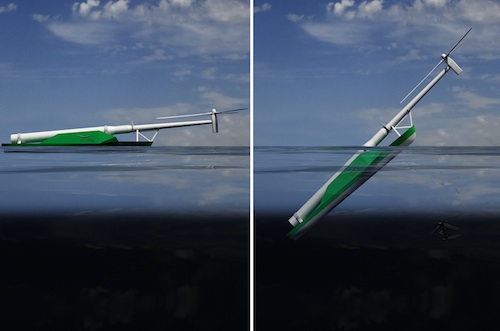
How WindFlip Will Deliver Gigantic Floating Turbines to Site
To tow the new gigantic off-shore wind turbines now being developed in Europe far out to sea, a Norwegian company has devised a clever and simple mechanism. Their WindFlip tows the turbine out almost horizontal – and then when it gets to the site, tilts it up into position – using only the weight of seawater to do it.
The structure contains 29 air filled compartments. Once at the site each of the compartments inside the Windflip is sequentially filled with water, causing the stern to slowly submerge, so that both the Windflip barge and the turbine it is holding flip up 90°. Then it releases the turbine for connection with a pre-installed mooring spread, and then tips the barge back to horizontal by clearing the ballast tanks of seawater with compressed air.

Their design has been recently been amped-up in response to the rising sizes of turbines being deployed. Now that a single turbine can be as large as 5 to 6 MW, WindFlip has been redesigned to accommodate turbines that large.
But the off-shore wind industry is now maturing in the EU. So other, and now more established companies have already invented ways to get gigantic wind turbines delivered out to sea. So WindFlip is focused on the next step for offshore wind: the floating turbine market.
“Earlier this year, WindFlip took the strategic decision to focus on the floating wind turbine niche,” says general manager Ane Christophersen.
“In the fixed turbine installation market there are a lot of big, established actors. We felt it might be that much harder for us to get into. But with the floating market, we can take the long-term view and try to develop a solution for them [turbine designers].
So, in conjunction with state funding through Innovation Norway and Norway’s Statoil, the developer of the Hywind floating turbine, Windflip has refined the processes for assembly, loading, transit and release in R & D in Marintek.
(The Statoil Hywind floating turbine is to be tested off the coast in deepwater Maine. Previous story: EU Invades US for Offshore Wind. The test was funded by the Department of Energy: Why DOE Funded Floating Turbines May Change the Future of Offshore Wind)
Some of the improvements include being able to tow the turbine at an angle so as to keep the delicate machinery in the nacelle 40 metres above the water (120 feet), and be able to navigate it in pretty rough seas. Now it could handle significant wave heights up to 2.5 meters (8 feet) — the point at which fast ferries stop their service — and still be able to protect its cargo.
The hull, decks and bulkheads are designed to withstand four bars of pressure, and the barge can move at over eight knots (14.8km/h or about 8 miles an hour). At full scale, the hull would measure 100 metres long (300 feet) and 30 metres (90 feet) wide, and be able to hold 17,000 cubic metres of ballast water when fully upended.
The hull is undergoing a re-fit to “match” Hywind — on the grounds that it is the “obvious choice as it is the most mature technology” and is likely to be the first floating turbine to go on sale in Europe, but it is also working with companies developing other types of floating designs.
The startup is looking for a partner to take it to full scale test and commercialization.
Source: Clean Technica
